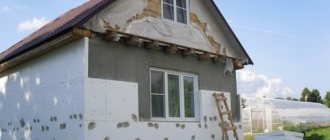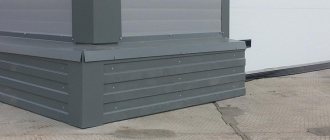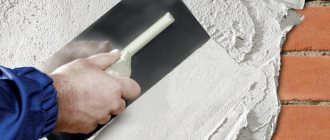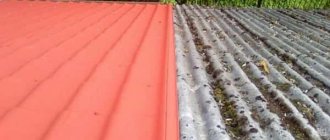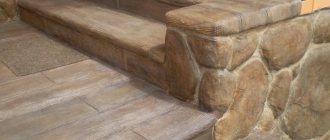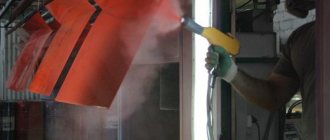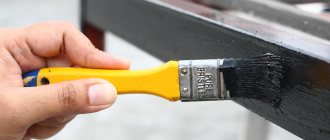The basement level of any building suffers most from negative environmental factors. Properly selected paint for the foundation is not just a finishing method, it is a modern method of protecting building materials from gradual destruction. The quality of innovative paint and varnish products is beyond doubt, but to make an informed choice it is important to understand them.
Painting the foundation of a house - what does it give?
The basement is the foundation of the house, an above-ground continuation of the foundation. The peculiarity of the foundation is that it will “grow” out of the ground, having direct contact with the acid-base environment of groundwater. No matter how high this level is, it is subject to significant stress from temperature changes and precipitation. The situation becomes more complicated when there is no blind area or sidewalk adjacent to the wall.
Suitable paint for the base protects it from the destructive effects of weather and climatic factors. It is not washed off, penetrating deeply into the porous structure of the concrete base, thereby forming a kind of protective impregnation of the surface. When you paint the base to look like stone yourself, the aesthetic characteristics of the outer part of the foundation also improve. Without base paint, the building loses not only its attractiveness. Premature “aging” and destruction of the outer part of the base gradually leads to uneven subsidence of the house. It can be aggravated by soil movement processes, then cracking of the walls and foundation appears, and the building becomes unsafe.
Latex film is an additional protection for the foundation from the outside.
When thinking about how to paint the outside of a house's concrete foundation, it is important to understand what it does later. Particularly destructive is moisture that penetrates deep into stone or brickwork, which, when frozen, destroys the materials of the base. Coating the base and blind area with high-tech silicone or rubber paint will help delay the destruction of a private house, cottage or country house. Therefore, it is legitimate to worry about how to paint the foundation of a cement house. This is the first thing you need to take care of after completing the main part of the construction and installation work.
Suitable paint for the base protects it from the destructive effects of weather and climatic factors.
Today there is no shortage of specialized compounds for outdoor work. They will be shown in the nearest construction supermarket, they are in any catalog of paint and varnish mixtures. There are highly specialized and universal paints that can be used to coat any material:
- Natural and artificial stone;
- Brickwork;
- Ceramic cladding.
The owner of his own home only needs a little advice on how to paint his concrete foundation plinth to ensure maximum protection.
Today there is no shortage of specialized compounds for outdoor work.
Advantages and disadvantages
Any paint for foundations on concrete is reliable, which one is better for the material with which the base is lined, follows from the sum of its pros and cons. Each coloring composition has a number of positive characteristics; they are relied upon to a greater extent when choosing.
Most specialized foundation paints for concrete have the following important qualities:
- Aesthetics, some formulations have improved properties;
- Large selection of color and texture variations of facade paints;
- Cost-effectiveness is not only an affordable price, it also extends the service life of the finishing cladding of the foundation;
- Ease of use (quick painting is guaranteed if all technological requirements for surface preparation are met);
- Possibility of working under a wide range of temperatures and humidity);
- The ability to change the appearance of the building if you want to update the house and give it a more attractive look;
- Most latex compositions are water-based and environmentally friendly; the vapor-permeable film is able to “breathe”, releasing excess fumes.
Painting your home's foundation also has its downsides. But the short service life and high cost of some imported mixtures are insignificant compared to their excellent properties.
Large selection of color and texture variations of facade paints.
Why is it necessary to protect the foundation, plinth
Painting the base will solve a large number of problems. Timely painting using the paint most suitable for the home allows you to:
- Provide additional protection for the base. The base is affected by many unfavorable factors. Treatment of the porous surface gives it additional strength and resistance to external influences. In addition, this finish is very easy to update.
- Create an additional protective layer that will retain moisture while allowing vapor to escape. This will significantly extend the life of the house.
- Simplify the care process. The basement gets dirty much more than the rest of the building. The right choice of paint will make it possible to clean it without much effort, as well as renew it if necessary.
- Hide minor defects and make the appearance of the house attractive. By using a combination of different shades on the base and facade, you can realize bold design ideas.
The base part will last for many years
A significant advantage of painting the base is the cost-effectiveness of such finishing. The cost of the paint is quite reasonable, and it will take a maximum of a day to complete all the work.
Requirements for paints
Today, ready-made latex paint for foundation plinths is produced in the form of a concentrated composition that requires dilution with water or solvents in a certain proportion. It is important to read the recommendations on the packaging.
The principle of interaction between paint components and foundation materials is clear - to create maximum adhesion for the protective film. It should also:
- Possess a fire-resistant composition and do not emit caustic substances even during combustion;
- Block the destructive effects of acids and alkalis dissolved in the soil;
- Outside, protect the surface from slanting rain;
- Prevent the penetration of water into the concrete masonry, which is detrimental to the base, especially when temperatures fluctuate in winter;
- Possess vapor permeability, releasing excess moisture into the atmosphere;
- Have excellent aesthetics so that from the street the façade of the house looks quite respectable.
Summarizing all these factors, it becomes clear that the ideal paint for a concrete foundation should be, at a minimum, frost-resistant, moisture-resistant and vapor-permeable. Additional properties are environmental friendliness, practicality and durability.
The ideal foundation paint for concrete should be, at a minimum, frost-resistant, moisture-resistant and vapor-permeable.
If there is a large supply of paint left, you can use it to treat other surfaces that require protection:
- Blind area;
- Facade decor;
- Fences and fences;
- External stairs;
- Verandas and gazebos;
- Garden path edges;
- Poles for lighting gardens and areas.
Once the choice was limited, the base was covered with resin. Today there are no problems with what to paint or whitewash the foundation of a house. Modern offerings are affordable and easy to use. Manual (roller, brush) and mechanical painting are available. For better adhesion, specialized primers are used for all types of building materials.
For better adhesion, specialized primers are used for all types of building materials.
The feasibility of using paint for the foundation of a house
Basement paints and varnishes are suitable for any surfaces that are a continuation and wall of the foundation base.
We are talking about different types:
Brick and concrete are well strengthened and then insulated with heat insulators, on top of which a layer of plaster is necessarily applied. Painting this layer will reliably protect the surface from destruction, precipitation, fungi and mold.
Modern domestic and foreign manufacturers produce various types of paints and varnishes. The main feature of paints is that they:
- Reliably adhere to surfaces.
- Protect and improve the performance of the foundation.
- They are water and vapor permeable.
- Gives the walls a designer look.
- They are environmentally friendly and safe.
- latex,
- acrylic,
- alkyd,
- polyurethane paints and varnishes.
The composition of each type is characterized by:
- Instant drying.
- Reliability and durability.
- Resistant to mechanical stress.
- Impermeable to water and steam.
- Ease of application.
- Resistant to humidity, temperature and external pollution.
- Economy of quantitative consumption.
To achieve the listed properties, applying just one layer is sufficient. But in some cases, experts recommend covering the surface with several layers.
The peculiarity of any paints is that they must be compatible with the material from which the base is made. Experienced craftsmen recommend choosing it together with a primer, and both substances should complement each other. The primer penetrates into the pores of the wall, fills them, thereby significantly reducing the consumption of painting material.
A number of enamels are also suitable for wooden and metal surfaces:
They especially require painting. Paint protects wood from destruction and at the same time kills fungi, and metal from rust and further corrosion. The fresh facade of the house adds uniqueness to the structure and creates the effect of a good mood.
Before applying the paint, the surfaces are carefully prepared and primed. A layer of plaster, putty and primer applied to any surface has a thermal insulating effect, but it can also be covered with a layer of paint.
The outer coating forms a protective film that prevents the basement wall from interacting with the aggressive external environment, precipitation and humidity. The choice of paint color depends on the owner's project plan and personal preferences.
Epoxy paints are especially valued in the construction market . The new product has won the hearts of many users due to its composition, brilliance and quality.
Types of paints for painting concrete or cement plinths, which is better?
Having started to transform the house, you have to solve many problems - how to paint the base of the house over plaster or stone.
Acrylic paint
A water-soluble dye based on acrylates is one of the most popular varieties, which has also found worthy use as external coatings. Initially, environmentally friendly compositions, close to conventional water-based emulsion, were used only for interior work.
Today this is an improved formula, so they are included in the standard list of what to paint the foundation of a house with. A durable protective layer is a durable finish that offers superior aesthetics in any color, including black or brown foundations.
A durable protective layer is a durable coating with excellent aesthetics in any color.
Latex paint
Elastic water-based paint is one of the best suggestions when you are wondering how to paint the exterior of a house’s foundation. A water emulsion containing elastomers, which give it excellent properties - it repels dirt and water.
“Rubber” dyes have high hiding power, are easy to apply and dry relatively quickly. The alkali-resistant latex layer is resistant to aggressive weather and climate conditions.
“Rubber” dyes have high hiding power, are easy to apply and dry relatively quickly.
Epoxy paint
The composition is made on the basis of resinous substances. Epoxy resin is known to dry to form a hard polymer that resembles artificial amber. Paints on a similar basis also have this property.
The durable coating will last about 20 years, so you don’t have to think any further about how to paint the base of your house for a long time. It will protect the base from all unfavorable factors, without losing its attractiveness from UV rays and the acid-base environment of groundwater.
It will protect the base from all adverse factors.
Polyurethane paints
This variety is environmentally friendly; the composition does not produce caustic fumes. The durable film protects against destruction by active substances and is suitable for urban buildings and the private sector - it can be used to paint a cement base. Even with sudden temperature changes, the integrity of the coating is maintained.
This variety is environmentally friendly; the composition does not produce caustic fumes.
Alkyd paints
One of the best paints for plaster plinths, with excellent performance characteristics at an affordable price. It is one of the most popular enamels for exterior use.
In specialized stores they are presented in a large assortment - from domestic and foreign manufacturers. Preliminary priming of vertical surfaces is suggested. After painting, it perfectly prevents the penetration of moisture into concrete.
After painting, it perfectly prevents the penetration of moisture into concrete.
Oil paints
This variety is produced on the basis of vegetable drying oil, it is applied in 2-3 layers (intermediate time for drying), working in a respirator. It is undesirable to use bright shades on the sunny side, they will fade.
Oil paints are traditional compositions that reject moisture. This is a “classic” of paint and varnish mixtures. Although many mixtures with improved characteristics are offered today, this variety can be used for treating the basement level.
Oil paints are traditional compositions that reject moisture.
Cement
Silicate compositions are the optimal means for protecting the base; they are included in the category of facade varieties based on liquid glass. It has most of the properties inherent in water-based analogues. The use of such compositions does not require additional surface treatment. It is often applied without a primer. Painting the base usually lasts for at least 10 years - it does not fade, does not crack, and perfectly fixes the plaster and concrete facade.
Silicate compounds are the optimal means for protecting the base.
Types and characteristics of paints for protecting the base
For the lower part of the building, it is recommended to use the following types of paint for the plaster plinth:
- acrylic, diluted with water;
- alkyd, based on natural and synthetic solvents;
- silicone based;
- epoxy;
- polyurethane.
The material used for painting the base must be moisture-resistant and unaffected by low temperatures, with good adhesion and resistant to solar ultraviolet rays. Along with the paint and varnish material, it is necessary to purchase the appropriate primer for pre-treatment of the surface to be painted.
Acrylic paints
They apply easily to the surface and dry quickly, creating a durable waterproof layer that adheres well. The addition of latex enhances the hydrophobic properties of the material. Acrylic compositions are inexpensive and economical in consumption when painting. Can be used to cover smooth concrete and brick surfaces. Not recommended for protecting aerated concrete blocks and other highly porous materials.
Alkyd paint and varnish compositions
The film-forming base of alkyd paints are drying oils, oils, resins and other similar materials. Capable of providing a very high level of protection against moisture. However, they are susceptible to ultraviolet radiation and therefore require renewal on average every 3 years. It should be noted that the color range is wider and brighter than that of acrylic coatings.
Silicone based paints
These are modern paints and varnishes based on emulsified silicone resins. They are highly hydrophobic while remaining vapor permeable. Penetrates well into the substrate and is recommended for coating porous surfaces. The drying film ball of silicone paint does not create surface stresses and therefore adheres well to plastered surfaces.
Epoxy paints
They are the strongest and most durable. Ensures complete sealing of the coating. They consist of an epoxy base, a coloring pigment and a hardener, which is added to the composition just before application to the surface.
Epoxy paint can protect the base not only from precipitation, but also from strong mechanical influences. The main disadvantage of the material is its high cost.
Polyurethane coloring compounds
They allow you to create a textured pattern on the surface of the plinth, which improves the appearance of the building facade. In most cases, these are conventional paints and varnishes modified with polyurethane. This paint is durable and protects the surface well from moisture, but is much more expensive than traditional materials.
Materials and tools for work
For craftsmen who have confident painting skills, painting the basement of a house will not be difficult. You will need standard tools:
- Bayonet shovel for cleaning dirt;
- A hard metal brush for cleaning off deposits;
- Paint brushes and roller with attachments;
- Construction spray gun;
- Set of spatulas (trowel).
The set of tools may vary slightly, depending on the conditions of the work and the degree of neglect of the old foundation. A hose for rinsing under running water, brooms and brushes may be useful.
The set of tools may vary slightly, depending on the conditions of the work and the degree of neglect of the old foundation.
Product range
Manufacturers offer a large number of different types of paints on the Russian construction market. Finnish is the leader in the number of offers.
Among the Russian companies, the following companies can be noted:
- "Technoprok"
- "AB Decor"
- "Olkhon"
- "Let's make it easy"
- “Bobrovsky experimental and many others.
Rubber, latex, acrylic, silicone, alkyd, oil, enamels, polyvinyl acetate, fire-resistant, etc. paint and varnish materials are presented in a large assortment on the construction market.
A wide range of offers helps you choose exactly the type of paint that is most suitable for the surface of the building. When choosing the right coloring material, it is recommended to first pay attention to the packaging, which should indicate the increased water resistance of the material and its adhesiveness to alkalis.
Rubber
The material is used for exterior finishing.
A special latex composition, based on a special resin, is characterized by increased elasticity. And the coating film formed on the wall allows it to adapt to changing atmospheric conditions , shrinkage of a newly built house, and seismic changes.
House foundation painting technology
Before painting an outdoor concrete foundation, it is important to thoroughly clean it of mold and mildew, moss and dirt, and weed out adjacent vegetation.
Basic materials for painting:
- Cement or plaster mixture for sealing cracks;
- Good sealant;
- Basic dye;
- Deep penetration primer mixture.
Surfaces are painted in dry, cloudy weather.
Briefly, the process of self-painting looks like this:
- Removing soil from vegetation.
- Cleaning the foundation with a stiff brush.
- Elimination of defects and sealing of cracks, treatment with sealant.
- Washing the surface followed by drying.
- Primer treatment.
- Painting the foundation with the first layer. After drying, re-process.
Surfaces are painted in dry, cloudy weather.
As you can see, today there is no shortage of proposals for painting the foundation. A large assortment of paint and varnish products provides ample opportunity to choose the optimal composition for maximum protection of the base of any building.
Instructions for painting the base
After selecting and purchasing paint with the appropriate primer, you can begin painting the surface of the basement of the building. They include the following steps:
- cleaning from dirt and mold;
- primary priming;
- sealing cracks and leveling the surface;
- second soil treatment;
- coloring.
Tools for painting work you will need:
- paint brushes, roller or spray gun;
- paint roller tray or other wide container;
- spatula, wire brush, hammer and chisel;
- trowel, grater and short plastering rule.
In addition, you should prepare a tool for possible mechanical removal of mortar residues and other contaminants.
Surface cleaning
To remove dirt, use a spatula and a wire brush. Large remains of concrete and cement mortar should be chipped off with a chisel. You should also remove oil stains, old paintwork and tiles, if any. High-quality surface cleaning is an important basis for all subsequent work.
Cost of materials
Despite the fact that on the websites the paints are written at the same price, together with delivery to the regions of the Russian Federation it can cost much more. The price also depends on the amount of material in the package, composition and manufacturer.
Rubber paint costs from 650 rubles. Simple facade paint sells for 110 rubles. Acrylic paints (2.5 kg) are sold at a price of 950 rubles. Latex paints are sold from 80 rubles. The most expensive is heat-resistant paint, sold in 12 kg packages. Its cost is 7,800 rubles.
As for the cost of painting the base, in the Russian Federation it starts from 150 rubles per 1 m2.
Benefits of coloring
The advantages of all types of base paints are:
- Long service life.
- High-quality composition with modern polymers that improve its functions.
- Adhesion to mechanical damage and alkalis, protection from moisture and temperature influences.
- Reflection of UV rays.
- Resistant to stains.
- Supporting a layer of putty or plaster that sits on top of the base.
- Durability and low abrasion.
- High vapor permeability.
- Manufacturability and ergonomics.
- Fast drying time for most materials.
- The ability to do the work yourself, without the involvement of painters.
In addition, all materials are affordable and have good color saturation. The composition and components provide value for money of the composition.
A variety of options for finishing the basement of a private house are presented in this section.
You will find all the most important, interesting and useful information about finishing the basement in this section.
